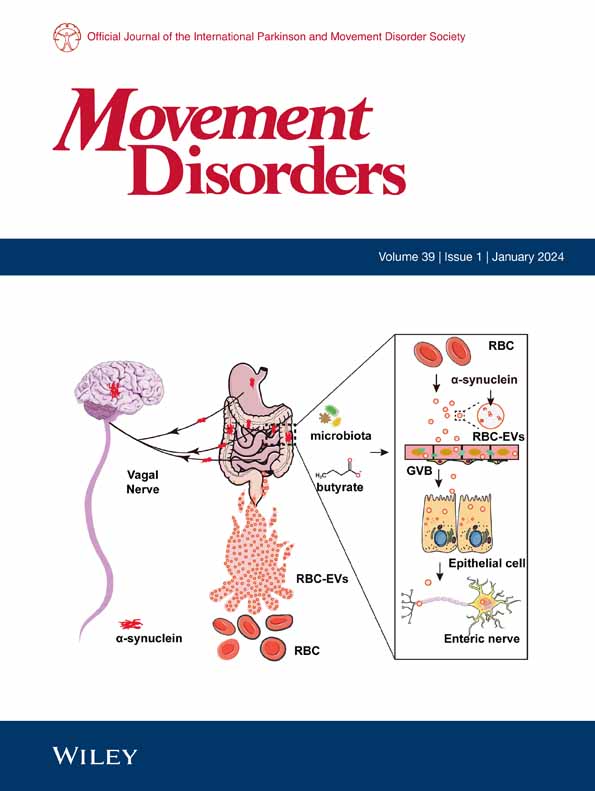Nocebo Hypothesis Cognitive Behavioral Therapy for Functional Neurological Symptom Disorder (Motor Type): A Pilot Randomized Controlled Trial.
IF 7.4
1区 医学
Q1 CLINICAL NEUROLOGY
引用次数: 0
Abstract
BACKGROUND A previous case series showed that Nocebo Hypothesis Cognitive Behavioral Therapy (NH-CBT) is a promising treatment for Functional Neurological Symptom Disorder (FNSD). OBJECTIVES To further evaluate the potential efficacy of NH-CBT in participants with FNSD (motor type). METHODS This phase IIb pilot, randomized, parallel group trial compared the efficacy of NH-CBT (n = 20) with an active control condition (n = 19). Self-report scales of motor and other physical symptoms, psychological variables, and blinded assessor ratings of participants' mobility were administered at baseline, and at 8- and 16-week follow-ups. The primary outcome and endpoint of this trial was the Physical Functioning scale of the Short Form-36 Health Questionnaire (SF-36 PF) at the end of treatment. RESULTS Regarding the primary endpoint (SF-36 at the end of treatment), we did not identify a significant between-group effect (d = 0.21, 95% CI: -0.42-0.84). Significant between-group effects in favor of NH-CBT were identified for several secondary outcomes (motor symptoms: d = 0.67, 95% CI: 0.02-1.32; mobility: d = 0.70, 95% CI: 0.05-1.35; symptom perception "concern": d = 0.66, 95% CI: 0.01-1.31). Changes in outcomes within the NH-CBT group showed large effects (d > 0.80) for the primary outcome (SF-36 PF) and the majority of secondary measures post-treatment. A significantly greater proportion of NH-CBT (85%) than control participants (47%) showed full recovery of motor symptoms (P = 0.013). CONCLUSIONS NH-CBT resulted in large within-group effects on the primary outcome as well as the majority of secondary measures in the NH-CBT group and a greater proportion of fully recovered participants compared with an active control treatment. These promising findings warrant a definitive trial. © 2025 The Author(s). Movement Disorders published by Wiley Periodicals LLC on behalf of International Parkinson and Movement Disorder Society.反安慰剂假说认知行为疗法治疗功能性神经症状障碍(运动型):一项随机对照试验。
背景:以前的病例系列表明,反安慰剂假说认知行为疗法(NH-CBT)是一种很有前途的治疗功能性神经症状障碍(FNSD)的方法。目的进一步评价NH-CBT治疗FNSD(运动型)的潜在疗效。方法本IIb期先导、随机、平行组试验比较了NH-CBT (n = 20)与主动对照(n = 19)的疗效。运动和其他身体症状的自我报告量表、心理变量和参与者活动能力的盲法评估者评分在基线、8周和16周随访时进行。该试验的主要结局和终点是治疗结束时SF-36健康问卷(sf - 36pf)的身体功能量表。关于主要终点(治疗结束时SF-36),我们没有发现显著的组间效应(d = 0.21, 95% CI: -0.42-0.84)。在几个次要结局中发现了支持NH-CBT的显著组间效应(运动症状:d = 0.67, 95% CI: 0.02-1.32;迁移率:d = 0.70, 95% CI: 0.05-1.35;症状感知“关注”:d = 0.66, 95% CI: 0.01 ~ 1.31)。在NH-CBT组中,主要结局(sf - 36pf)和治疗后大多数次要测量结果的变化显示出很大的影响(d > 0.80)。NH-CBT组运动症状完全恢复的比例(85%)明显高于对照组(47%)(P = 0.013)。结论snh - cbt组在主要结局和次要措施上均有较大的组内效应,且与积极对照治疗相比,snh - cbt组完全康复的参与者比例更大。这些有希望的发现值得进行明确的试验。©2025作者。Wiley期刊有限责任公司代表国际帕金森和运动障碍学会出版的《运动障碍》。
本文章由计算机程序翻译,如有差异,请以英文原文为准。
求助全文
约1分钟内获得全文
求助全文
来源期刊

Movement Disorders
医学-临床神经学
CiteScore
13.30
自引率
8.10%
发文量
371
审稿时长
12 months
期刊介绍:
Movement Disorders publishes a variety of content types including Reviews, Viewpoints, Full Length Articles, Historical Reports, Brief Reports, and Letters. The journal considers original manuscripts on topics related to the diagnosis, therapeutics, pharmacology, biochemistry, physiology, etiology, genetics, and epidemiology of movement disorders. Appropriate topics include Parkinsonism, Chorea, Tremors, Dystonia, Myoclonus, Tics, Tardive Dyskinesia, Spasticity, and Ataxia.
 求助内容:
求助内容: 应助结果提醒方式:
应助结果提醒方式:


